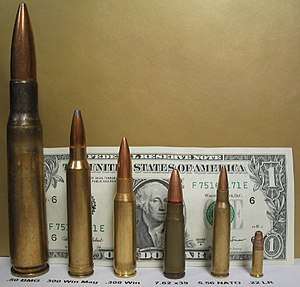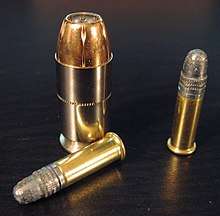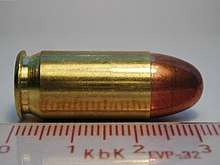Caliber
In guns, particularly firearms, caliber (or calibre in British English) is the specified nominal internal diameter of the gun barrel bore regardless of how or where the bore is measured and whether or not the finished bore matches that specification.[1] It is measured in inches to an accuracy of hundredths or thousandths of an inch or in millimeters.[2] For example, a ".45 caliber" firearm has a barrel diameter of roughly 0.45 inches (11 mm). Barrel diameters can also be expressed using metric dimensions. For example, a "9 mm pistol" has a barrel diameter of about 9 millimeters. Due to the inaccuracy and imprecision of imperial dimensions "converted" to metric units, metric designations are typically far out of specifications published in decimal inches. True "caliber" specifications require imperial measure, and even when cartridge designations (often mistakenly referred to as "caliber") only specify caliber to even tenths or hundredths of an inch, actual barrel/chamber/projectile dimensions are published to at least thousandths of an inch and frequently tolerances extend into ten-thousandths of an inch.



In a rifled barrel, the distance is measured between opposing lands or between opposing grooves; groove measurements are common in cartridge designations originating in the United States, while land measurements are more common elsewhere in the world. Measurements "across the grooves" are used for maximum precision because rifling and the specific caliber so-measured is the result of final machining process which cuts grooves into the rough bore leaving the "lands" behind.
Good performance requires a concentric, straight bore that accurately centers the projectile within, in preference to a "tight" fit which can be achieved even with off-center, crooked bores that cause excessive friction, fouling and an out-of-balance, wobbling projectile in flight.
While modern firearms are generally referred to by the name of the cartridge the gun is chambered for, they are still categorized together based on bore diameter. For example, a firearm might be described as a "30 caliber rifle", which could be any of a wide range of cartridges using a roughly 0.30 inches (7.6 mm) projectile; or a "22 rimfire", referring to any rimfire firearms firing cartridges with a .22 caliber projectile. However, there can be significant differences in nominal bullet and bore dimensions and all cartridges so "categorized" are not automatically identical in actual caliber.
For example, .303 British firearms and projectiles are often "categorized" as ".30-caliber" alongside several dozen U.S. ".30-caliber" cartridges despite using bullets .310–.312″ diameter while all U.S ".30-caliber" centerfire rifle cartridges use a common, standard .308″ bullet outside diameter. Using bullets larger than design specifications causes excessive pressures while undersize bullets cause low pressures, insufficient muzzle velocities and fouling that will eventually lead to excessive pressures.
Calibers fall into four general categories by size. Small-bore refers to calibers with a diameter of .32 inch or smaller. The medium-bore refers to calibers with a diameter between .33 inch up to .39 inch and large-bore refers to calibers with a diameter of .40 inch or larger. Miniature bore historically referred to calibers under .22. There is much variance in the use of the term small-bore which over the years has changed considerably with anything under .577 caliber considered small-bore prior to the mid-19th century.
Cartridge naming conventions
Makers of early cartridge arms had to invent methods of naming cartridges since no established convention existed then.[3] One of the early established cartridge arms was the Spencer repeating rifle, which Union forces used in the American Civil War. It was named based on the chamber dimensions, rather than the bore diameter, with the earliest cartridge called the "No. 56 cartridge", indicating a chamber diameter of .56 in; the bore diameter varied considerably, from .52 to .54 in. Later various derivatives were created using the same basic cartridge, but with smaller-diameter bullets; these were named by the cartridge diameter at the base and mouth. The original No. 56 became the .56-56, and the smaller versions, .56-52, .56-50, and .56-46. The .56-52, the most common of the new calibers, used a 50-cal bullet.
Other black powder-era cartridges used naming schemes that appeared similar, but measured entirely different characteristics; .45-70, .44-40, and .32-20 were designated by bullet diameter to hundredths of an inch and standard black powder charge in grains. Optionally, the bullet weight in grains was designated, e.g. .45-70-405.[4] This scheme was far more popular and was carried over after the advent of early smokeless powder cartridges such as the .30-30 Winchester and .22 Long. Later developments used terms to indicate relative power, such as .44 Special and .44 Magnum. Variations on these methods persist today, with new cartridges such as the .204 Ruger and .17 HMR (Hornady Magnum Rimfire).
Metric diameters for small arms refer to cartridge dimensions and are expressed with an "×" between the bore diameter and the length of the cartridge case; for example, the 6.5×55mm Swedish cartridge has a bore diameter of 6.5 mm and a case length of 55 mm.[5]
The means of measuring a rifled bore varies, and may refer to the diameter of the lands or the grooves of the rifling.[6] For example, the .257 Roberts and .250 Savage both use a .250 inch projectile; both .250 and 257 rifle bores have the a .250 inch land diameter and .257 inch groove diameter.[7] The .308 Winchester is measured across the grooves and uses a .308-in diameter (7.82-mm) bullet; the military-specification version is known as 7.62×51mm NATO, so called because the bore diameter measured between the lands is 7.62 mm, and the cartridge has a case 51 mm long.[8]
Metric and US customary
The following table lists some of the commonly used calibers where both metric and US customary are used as equivalents. Due to variations in naming conventions, and the whims of the cartridge manufacturers, bullet diameters can vary widely from the diameter implied by the name. For example, a difference of 0.045 in (1.15 mm) occurs between the smallest and largest of the several cartridges designated as ".38 caliber".
| Inch caliber | Metric caliber | Typical bullet diameter | Common cartridges | Notes |
|---|---|---|---|---|
| .172 | 4 mm | 0.172 in | .17 HMR, .17 Hornet, .17 Ackley Hornet, .17 Winchester Super Magnum, .17-32 Magnum, .17 VHA, .17 Remington, .17/222, .17 Mach III-IV, .17 Ackley Improved Bee, .17-357 RG, .17 Remington Fireball, .17 Incinerator, 4.39×39Rmm SPS | |
| .20, .204 | 5 mm | 0.204 in | .204 Ruger, 5mm Remington Rimfire Magnum | |
| .221 | 5.45 mm | 0.221 in | 5.45×39mm Russian family | Russian Mil Std |
| .22 | 5.6 mm | 0.223 in | .22 Short, .22 Long, .22 Long Rifle, .22 Stinger, 22 Extra Long, .22 WMR (magnum), .297/230 Morris Extra Long, .22 Hornet, .22 Rem Automatic, 5.66 x39 MPS, .22 Rem Jet | |
| .224 | 5.7 mm | 0.224 in | .218 Bee, .219 Zipper, .22 Hornet-K, .220 Swift, .222 Remington, .222 Remington Magnum, .223 Remington, 5.56×45mm NATO, 5.7×28mm, .22 TCM, 5.8 × 42 Chinese, .224 Weatherby Magnum, .225 Winchester, .223 Winchester Super Short Magnum (Obsolete) .223 Ackley Improved, .219 Donaldson Wasp, .221 Remington Fireball, .22-250 Remington and many more | |
| .243 | 6 mm | 0.243 in | .243 Winchester, .244 Remington, 6mm Remington, 6mm Whisper, 6mm PPC, 6mm Bench Rest Remington, 6×45mm, 6×47mm, 6mm Cheetah, .240 Weatherby, 6×62 Freres, 6mm Norma BR, 6XC Tubb, 6mm JDJ, 6mm SAW, 6-250 Walker, 6.17 Spitfire, 6.17 Flash, 6mm Lee Navy, and more, | |
| .25 | 6.35 mm | 0.257 in, 6.35 mm | .25 ACP (0.251"), 250/3000 Savage, 257 Roberts, .25-06 (0.257"), | also called .25 Auto and 6.35mm Browning |
| .26 | 6.5 mm | 0.264 in, 6.7 mm | 6.5×55mm Swedish, .260 Remington, .26 Nosler, 6.5mm Creedmoor, 6.5×47mm Lapua | cartridges commonly known as '6.5 mm' |
| .27 | 6.8 mm | 0.277 in, 7.035 mm | .270 Winchester, 6.8 SPC | |
| .284 | 7 mm | 0.284 in, 7.213 mm | .280 Remington, 7mm-08 Remington, 7mm Weatherby Magnum, 7mm Remington Magnum, 7×57mm Mauser, 7×64mm | commonly called '7 mm' |
| .308 | 7.62 mm | 0.308 in, 7.82 mm | .30 Luger (7.65 × 21mm Luger), .30-30 Win, 30 Herrett, .300 Whisper, .30-378 Weatherby, 7.63 Mannlicher–Schoenauer, 7.63 Mauser, .30 USA Rimless, .308 Corbon, .3-9 Savage, .30 Kurz, 300 AAC Blackout (7.62×35mm), 7.5mm Schmidt–Rubin, .300 Winchester Magnum, .30 Carbine, 309 JDJ, .30-03, .30-06 Springfield, .30-06 JDJ, .307 GNR, .308 Winchester (7.62×51mm NATO), .300 Weatherby Magnum, .30 Army (.30-40 Krag), 7.82mm Lazzeroni, and dozens more | |
| .311 | 7.9 mm | 0.311 in, 7.92 mm | .303 British, 7.62×39mm Soviet, 7.62×54mmR, 7.62×25mm, 7.7×58mm | 7.62×54mmR is actually 7.92 mm (Mosin, SVD, PKM, etc.) The same applies to 7.62×39mm (AK-47, AKM, etc.) |
| .312 | 7.94 mm | 0.312 in, 7.94 mm | .32 ACP | Also known as 7.65 × 17 mm Browning |
| .323 | 8 mm | 0.323 in, 8.20 mm | 8×57mm IS, .325 WSM, 8mm Remington Magnum, 8 mm plastic (airsoft) BBs | .32 caliber rifle cartridges |
| .338 | 8.6 mm | 0.338 in | .338 Lapua, .338 Norma Magnum, .338 Winchester Magnum, .338-378 Weatherby Magnum | C14 Timberwolf (Canadian Forces) |
| .355 | 9 mm | 0.355 in | 9mm Luger, 9×19mm Parabellum, 9mm Ultra, 9mm Bayard Long, 9mm Browning Long, 9mm Mauser, 9mm Winchester Magnum, 9mm Glisenti, 9 × 21mm, 9 × 23mm Winchester, 9mm Mi-Bullet, 9mm Steyr, .356 Team Smith & Wesson, 9mm Federal, 9mm × 25mm Dillon, 9mm Action Express, .357 SIG. | |
| .356 | 9 mm | 0.356 in | .380 ACP (9mm Short), 9×56mm Mannlicher–Schoenauer, 9mm × 57mm Mauser | |
| .357 | 9 mm | 0.357 in | .38 Super, .38 Special, .357 Magnum, .35 Remington | Handgun cartridges known as "38" are .357 caliber. Generally .357 for revolvers and rifles, .355 in autoloaders |
| .363 | 9 mm | 0.363 in | 9×18mm Makarov | |
| .365 | 9.3 mm | 0.365 in | 9.3×62mm, 9.3×64mm Brenneke, 9.3×72mmR, 9.3×74mmR | |
| .375 | 9.5 mm | 0.375 in, 9.53 mm | .375 H&H Magnum, 9.5×57mm Mannlicher–Schönauer (.375 Rimless Nitro Express (RNE) × 2¼) | |
| .40 | 10 mm | 0.400 in | .40 S&W, 10mm Auto | |
| .44 | 10.9 mm | 0.429 in | .444 Marlin, .44 S&W Russian, .44 S&W Special, .44 Remington Magnum, .44 Auto Mag, .440 Cor-Bon, .44/454 JDJ Woodswalker | |
| .45 | 11.43 mm | 0.451–0.454 in | .45 ACP, .45 GAP, .454 Casull, .45 Long Colt, .455 Webley | Bullet diameter depends on bullet type/material. Generally 0.451 in for full metal jacket bullets and 0.454 in for lead bullets. |
| .50 | 12.7 mm | 0.510 in, 12.95 mm | .50 BMG, .50 Action Express, 12.7×108mm, .500 S&W Magnum, .50 Beowulf | M2 Browning machine gun and other heavy machine guns, long-range rifles typified by Barrett products. Desert Eagle handgun. |
Shotguns
Shotguns are classed according to gauge, a related expression. The gauge of a shotgun refers to how many lead spheres, each with a diameter equal to that of the bore, amount to one pound (approximately 454 grams) in weight. In the case of a 12-gauge shotgun, it would take 12 spheres the size of the shotgun's bore to equal a pound.[14] A numerically larger gauge indicates a smaller barrel: a 20-gauge shotgun requires more spheres to equal a pound; therefore, its barrel is smaller than the 12-gauge. This metric is used in Russia as "caliber number": e.g., "shotgun of the 12 caliber." The 16th caliber is known as "lordly" (Russian: барский). While shotgun bores can be expressed in calibers (the .410 bore shotgun is in fact a caliber measure of .41 caliber [10.4 mm]),[15] unlike with rifles the actual bore diameter of a smoothbore shotgun varies significantly down the length of the barrel due to various chokes (and sometimes back-boring).
Caliber as measurement of length
The length of artillery barrels has often been described in terms of multiples of the bore diameter e.g. a 4-inch gun of 50 calibers would have a barrel 4 in × 50 = 200 in long. A 50 caliber 16 inch gun (16 inch diameter shell), has a barrel length (muzzle to breech) of 50 × 16 = 800 in (66 ft 8 in). Both 14-in and 16-in navy guns were common in World War II. The British Royal Navy insisted on 50-cal guns on ships as it would allow 1,900 to 2,700 lb (860 to 1,220 kg) shells to travel at an initial velocity of up to 1,800 mph (2,897 km/h) to a distance of 26 mi (42 km).
Pounds as a measure of cannon bore
Smoothbore cannon and carronade bores are designated by the weight in imperial pounds of spherical solid iron shot of diameter to fit the bore. Standard sizes are 6, 12, 18, 24, 32, and 42 pounds, with some 68-pound weapons, and other nonstandard weapons using the same scheme. See Carronade#Ordnance.
From about the middle of the 17th century until the middle of the 19th century, measurement of the bore of large gunpowder weapons was usually expressed as the weight of its iron shot in pounds. Iron shot was used as the standard reference because iron was the most common material used for artillery ammunition during that period, and solid spherical shot the most common form encountered. Artillery was classified thereby into standard categories, with 3-pdr., 4-pdr., 6-pdr., 8-pdr., 9-pdr., 12-pdr., 18-pdr., 24-pdr., and 32-pdr. being the most common sizes encountered, although larger, smaller and intermediate sizes existed.
In practice, though, significant variation occurred in the actual mass of the projectile for a given nominal shot weight. The country of manufacture is a significant consideration when determining bore diameters. For example, the French livre, until 1812, had a mass of 489.5 g whilst the contemporary English (avoirdupois) pound massed approximately 454 g. Thus, a French 32-pdr at the Battle of Trafalgar threw a shot with 1.138 kg (2.51 lb) more mass than an English 32-pdr.
Complicating matters further, muzzle-loaded weapons require a significant gap between the sides of the tube bore and the surface of the shot. This is necessary so the projectile may be inserted from the mouth to the base of the tube and seated securely adjacent the propellant charge with relative ease. The gap, called windage, increases the size of the bore with respect to the diameter of the shot somewhere between 10% and 20% depending upon the year the tube was cast and the foundry responsible.
| gun class (pdr.) | projectile mass (kg) | shot diameter (cm) | shot volume (cm3) | approx. service bore (cm) |
|---|---|---|---|---|
| 2 | 0.9 | 6 | 115 | 6.6 |
| 3 | 1.4 | 6.9 | 172 | 7.6 |
| 4 | 1.8 | 7.6 | 230 | 8.4 |
| 6 | 2.7 | 8.7 | 345 | 9.6 |
| 9 | 4.1 | 10 | 518 | 11 |
| 12 | 5.4 | 10.9 | 691 | 12.1 |
| 18 | 8.2 | 12.6 | 1037 | 13.8 |
| 24 | 10.9 | 13.8 | 1383 | 15.2 |
| 32 | 14.5 | 15.2 | 1844 | 16.7 |
| 64 | 29 | 19.2 | 3687 | 21.1 |
The relationship between bore diameter and projectile weight was severed following the widespread adoption of rifled weapons during the latter part of the 19th century. Guns continued to be classed by projectile weight into the mid-20th century, particularly in British service. However, this value no longer definitively related to bore diameter, since projectiles were no longer simple spheres—and in any case were more often hollow shells filled with explosives rather than solid iron shot.
See also
- List of cartridges by caliber
- List of handgun cartridges
- List of rifle cartridges
- List of the largest cannons by caliber
Notes
- Brown, Edmund G. (2009). Handgun Safety Certificate. West Sacramento, California: California Department of Justice. p. 52.
- Barnes, Frank C. (2016). Woodard, W. Todd (ed.). Cartridges of the World: A Complete and Illustrated Reference for More than 1500 Cartridges (15th ed.). Iola, Wis.: Krause Publications. p. 9. ISBN 1440246424. OCLC 934886116.
- Barnes, Frank C. (1997) [1965]. McPherson, M.L. (ed.). Cartridges of the World (8th ed.). DBI Books. pp. 8–12. ISBN 0-87349-178-5.
- Barnes, Cartridges of the World 15 Edition 2016, p. 9.
- Barnes, Cartridges of the World 15 Edition 2016, p. 9.
- Barnes, Cartridges of the World 15 Edition 2016, p. 9.
- Van Zwoll, Wayne (2011). Shooter's bible guide to rifle ballistics. Skyhorse Publishing. p. 18. ISBN 978-1-61608-224-6.
- Barnes, Cartridges of the World 15 Edition 2016, p. 670.
- Accurate (2000). Accurate Smokeless Powders Loading Guide (Number Two (Revised) ed.). Prescott, AZ: Wolfe Publishing. p. 392. barcode 94794 00200.
- "Pistol and Rifle Lead Bullets".
- "Rifle Bullets".
- "LeadSafe Total Copper Jacket ("TCJ") Bullet List". Archived from the original on 1999-02-18. Retrieved 2007-12-05.
- Frank C Barnes. Cartridges of the World (14th ed.). Gun Digest Books.
- Barnes, Cartridges of the World 15 Edition 2016, p. 629.
- Barnes, Cartridges of the World 15 Edition 2016, p. 629.
References
- Barnes, Frank C. (2016). Woodard, W. Todd (ed.). Cartridges of the World: A Complete and Illustrated Reference for More than 1500 Cartridges (15th ed.). Iola, Wis.: Krause Publications. ISBN 1440246424. OCLC 934886116.